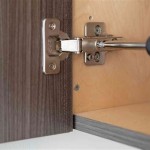How To Change the Stain on Kitchen Cabinets
Changing the stain on kitchen cabinets can dramatically update a kitchen's appearance without the expense of full replacement. This process involves several key steps, requiring careful preparation and execution for optimal results. This article provides a comprehensive guide to achieving a professional-looking finish.
1. Preparing the Work Area: The initial step involves creating a clean, well-ventilated workspace. Cabinets should ideally be removed and placed in this area. Covering the work surface with drop cloths or plastic sheeting protects against spills and stains. Proper ventilation is crucial for safe handling of chemical strippers and stains.
2. Removing Hardware: All hardware, including hinges, knobs, pulls, and catches, must be removed before beginning the refinishing process. This prevents damage to the hardware and allows for more thorough stripping and staining. Storing hardware in labeled bags can simplify reinstallation.
3. Stripping the Existing Finish: There are two primary methods for removing the existing finish: chemical stripping and sanding. Chemical strippers are effective for removing multiple layers of finish, but require careful handling due to their caustic nature. Following the manufacturer's instructions precisely is essential for safety and efficacy. Sanding, while more labor-intensive, offers greater control and avoids the use of harsh chemicals. Start with a coarser grit sandpaper (e.g., 100-grit) and progressively move to finer grits (e.g., 220-grit) to achieve a smooth surface.
4. Cleaning the Cabinets: After stripping, thorough cleaning is essential to remove any residue from the stripper or sanding dust. A tack cloth can effectively remove fine dust particles. For chemical stripping residue, a solution of warm water and mild dish soap, followed by a clean water rinse, is recommended. Allow the cabinets to dry completely before proceeding.
5. Repairing Imperfections: Once the cabinets are clean and dry, any imperfections, such as dents, scratches, or gouges, should be addressed. Wood filler can be used to fill these imperfections. Allow the filler to dry completely and sand smooth before moving on to the staining process.
6. Selecting the Stain: Choosing the appropriate stain is a crucial step in achieving the desired aesthetic. Test the stain on an inconspicuous area of the cabinet or a scrap piece of the same wood species to ensure the color matches expectations. Consider factors such as the wood species, existing undertones, and desired final appearance. Various stain types are available, including oil-based, water-based, and gel stains, each with its own characteristics and application methods.
7. Applying the Stain: Apply the stain evenly using a brush, rag, or foam applicator, following the manufacturer’s instructions. Work in the direction of the wood grain for a more natural appearance. The number of coats required will depend on the desired depth of color and the type of stain used. Allow each coat to dry completely before applying subsequent coats. Multiple thin coats generally provide a more even and professional finish than one thick coat.
8. Removing Excess Stain: After applying the stain, remove any excess stain with a clean cloth, wiping in the direction of the wood grain. This prevents blotching and ensures a uniform color. The timing for wiping off excess stain varies depending on the type of stain and ambient temperature, so consult the manufacturer's instructions for specific guidance.
9. Applying a Topcoat: A topcoat protects the stained surface from scratches, moisture, and general wear and tear. Several options are available, including polyurethane, varnish, and lacquer. Each offers varying degrees of durability and sheen. Apply the topcoat in thin, even coats, following the manufacturer’s instructions, allowing each coat to dry completely before applying the next. Lightly sanding between coats with fine-grit sandpaper can enhance the smoothness of the final finish.
10. Reinstalling Hardware and Cabinets: Once the topcoat has fully cured, reinstall the hardware. Care should be taken to avoid scratching the newly finished surface. After hardware installation, the cabinets can be reinstalled in their original locations, completing the transformation.
Important Considerations: Throughout the process, safety precautions should be observed. Wear appropriate safety glasses and gloves when working with chemical strippers and stains. Ensure adequate ventilation to prevent the buildup of fumes. Proper disposal of used chemicals and materials is also essential.

Staining Your Wood Cabinets Darker Young House Love

How To Stain Oak Cabinetry Tutorial The Kim Six Fix

How To Refinish Wood Cabinets The Easy Way Love Remodeled

How To Strip And Re Stain Kitchen Cabinets Clinton Township Mi Eason Painting

How To Make Rustic Kitchen Cabinets By Refinishing Them The Best Stain Color Amanda Katherine

How To Refinish Wood Cabinets The Easy Way Love Remodeled

How To Stain Wood Cabinets True Value

Diy Staining Oak Cabinets Eclectic Spark

How I Updated My Oak Cabinets Without Paint By Using Briwax Easy Budget Kitchen Makeover Only 24

Stain Cabinet Color Change N Hance Of Boise
Related Posts








